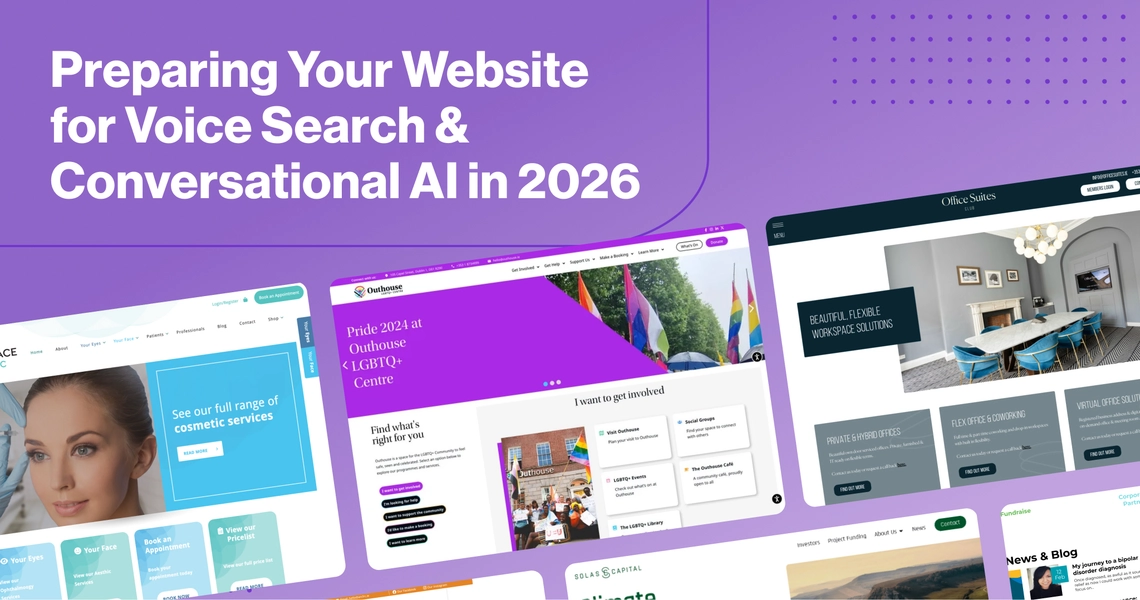Summary
Voice search and conversational AI are shifting how users find information online. With more people speaking into their devices – whether via smart speakers, voice assistants on phones, or within conversational UIs – businesses need to adapt. If your site is optimized only for typed queries, you risk losing visibility and user engagement. In this post, we’ll explore how to future-proof your website for voice and conversational interaction in 2026 and beyond.
Voice Search vs. Traditional Search: What’s Different?
Voice queries tend to be more natural, longer, and phrased as questions. For example:
- Typed: “plumber dublin price”
- Voice: “Hey Google – how much does a plumber in Dublin charge per hour?”
Because of this, search engines often return featured snippets, direct answers, or conversational results. Therefore, an effective voice-optimised site needs:
- Clear, direct answers
- A focus on question/answer content
- Structured markup to help search engines understand content
Technical & Content Strategies for Voice Optimisation
1. Use Schema / Structured Data
Implement schema markup (e.g. FAQ schema, Q&A schema, LocalBusiness schema) to help search engines recognise your content as answerable in voice interfaces.
2. FAQ / Q&A Format
Design pages with question headings (“How do I …?”, “What is …?”) and succinct, helpful answers immediately below. This encourages your content being considered for voice responses.
3. Conversational Tone & Clarity
Write in a tone that mirrors how people speak. Use simple, concise sentences. Avoid jargon unless necessary.
4. Local & “Near Me” Optimisation
Many voice searches are local queries (e.g. “near me,” “in Dublin,” “open now”). Make sure your Google Business Profile is up to date, your address & phone appear on site, and local landmarks are referenced.
5. Performance Matters
Voice users expect fast responses. Ensure your site loads quickly, has strong Core Web Vitals scores, and is responsive on mobile. Slow load times hurt both voice result eligibility and user experience.
Conversational AI & On-Site Chatbots
Beyond passive voice search, many sites now integrate conversational AI (chatbots, interactive assistants) to guide users. Some best practices:
- Use a clear greeting and guide the user (“How can I help you today?”)
- Anticipate common queries and script fallback flows
- Make handoff seamless from bot to human support
- Monitor chat logs to identify content gaps or UX issues
When your on-site AI mimics how people talk, you’re aligning your site’s conversational behavior with how voice users think.
Measuring Success: Voice & Conversational Metrics
Since voice interactions are not always tracked in the same way as typed search, your analytics strategy should include:
- Monitoring featured snippet / “position zero” impressions
- Tracking organic traffic uplift on FAQ / Q&A pages
- Comparing click-throughs from voice responses
- Evaluating chatbot interactions: number of chats initiated, solved via bot, escalated
This triangulation helps you understand how well your conversational efforts perform.
Voice search and conversational AI are no longer futuristic – they’re part of how users expect to interact online now. By structuring your content for questions, maintaining speed and clarity, and integrating conversational interfaces, you can make your site ready. Don’t wait – start positioning your site for voice in 2026 and gain an edge in search and usability.



